One of the common features on small “straight-stitch” sewing machines is a little rod on the top, called a spool pin. The spool pin holds a spool of thread and allows it to turn freely and feed out thread while the machine operates.
Seems straightforward enough, right? But what if you want to start working with larger spools of thread? Here’s an example that we brought home recently that, on first blush, just doesn’t look like it will work:
By comparison, the standard spool of thread looks puny, and the spool pin looks even punier. Even if this large spool were able to fit onto our tiny spool pin, it could not spin freely because of its weight and friction.
So how can we use the spool? Our solution was to design a larger, heavy-duty “spool spinner,” incorporating low-friction precision ball bearings. Total budget: $0.00– using stuff from the junk bin only– and under five minutes.
Parts used: an old “box” or “muffin” fan (the older and heavier the better), some rubber feet, a little piece of copper pipe, and superglue.
The fan that we found is an old 120 V AC type, made of cast aluminum and very sturdy. It doesn’t matter if it is electrically good; all that matters is that it spins well. To the spinning part of the fan we added a short copper pipe as our center pin, which turned out to be about the right size for the center of this particular spool. We used superglue to hold the copper piece in place. (Note: waiting for the glue to cure is the slow part of this build.)
Add rubber feet to the other side of the fan and it’s ready to go.
Rather than keeping ours on top of the sewing machine we put it on the printer next to the sewing table, where it is less likely to get knocked over. (Side note: The cat enjoyed this setup.)
In practice, the fan bearing turns freely enough that the sewing machine can spin the spool as needed, but not so freely that it starts to turn and then unwinds the whole spool, so it works quite well.
Obviously this is a quick hack and is not the only approach to the problem– there’s nothing so fancy as a ball-bearing spool spinner on an industrial sewing machine, even though it can use huge spools. Instead, the spool is held in place while the thread is pulled off axially through a well-defined aperture. (Spools like this one, as you can tell from the slight conical taper, are actually designed to be used that way.) An advantage of our “spinner” design is that it works equally well with many different kinds of spools. It could even be a useful tool when winding coils from spools of wire.




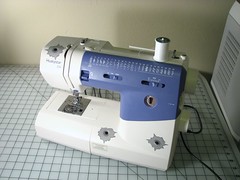
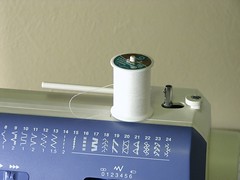
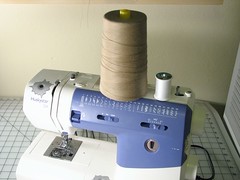
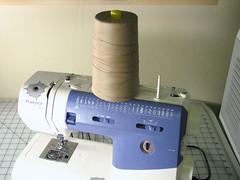

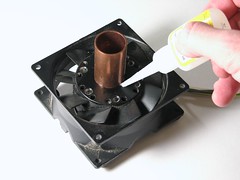
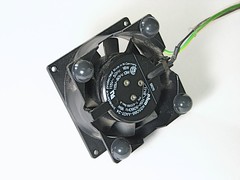
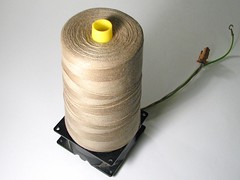
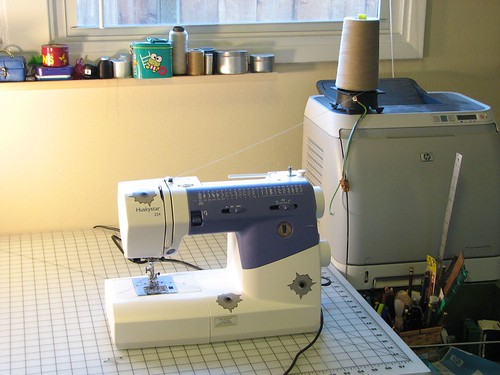
Rather than trying to make the giant spools spin, I just put a hook directly above the spool – so it unwinds straight up. It’s how the spools are set up on my industrial sewing machine, no moving parts to break. Low tech, but easy, although has no ‘tech win points’ as yours does :)
I actually just put a plastic drinking straw over the small spool peg and placed the big spool on top. It wobbles like crazy when I am sewing fast, but it has yet to fall off.
You do know the big spools are designed for surgers and are generally two-ply thread and not three-ply commonly used in standard machines, right?
This particular spool is bigger than I’ve seen on a serger, but I don’t get out much ;)
It’s 6000 yards of D-core tex 105, intended for sewing jeans and so forth. I don’t seen any indication from manufacturers of this kind of stuff that it’s not suitable for a standard machine, given the right size needle (Singer 22 or larger).
—
Windell H. Oskay
drwho(at)evilmadscientist.com
http://www.evilmadscientist.com/
An old lady once told me to put the spool in a peanut butter jar (when they were glass, I assume) behind the sewing machine to get them to work. I’m sure there are a zillion more ways (like using a fan). I’m always fascinated by what sewing techniques people have come up with over the ages.
Nato
nataliejaynewood@gmail.com
Too lazy to create an account
I have a lovely image in my head of a little spool bouncing around in a jar as it unwinds. However, for this size of spool, we’d probably need a gallon jar — and I don’t use quite that much peanut butter.
I’ve seen a lot of “you should use the hooks designed for this” response, so I’d like to answer that issue. If I had an industrial machine with a way to mount a hook like that for a spool like this I probably would. However, since I’m using a personal machine with a thread spool designed for an industrial machine, all bets are off. The super smooth bearings in the fan allow the spool to turn with minimal effort, so it is comparable to the behavior of a regular spool of thread on a regular spindle on a personal machine.
Additionally, when you use a spool where you have the thread pulled from the top, it gradually twists the thread. Most of the time this doesn’t matter, but with certain types of thread, the extra twisting causes more frequent tangles and breakages. Because of that, I prefer to pull off the side of the spool whenever possible.
And one last thing: this particular spool of thread is huge. You may not be able to tell from the photos, but this is not just your little serger spool. This is a massively heavy spool of heavy duty thread for sewing denim and canvas. It is really, really big. It should last me through at least a couple more CandyFab canvas covers.
I am a service technician for sewing amd embroidery machines. What you need is a spool stand. Here is a url – http://www.sewingmachine.com/sesewing/images/items/conestand.jpg
you should try to put an LED (big things in here) to the end of the cables to see how much electricity it`s producing